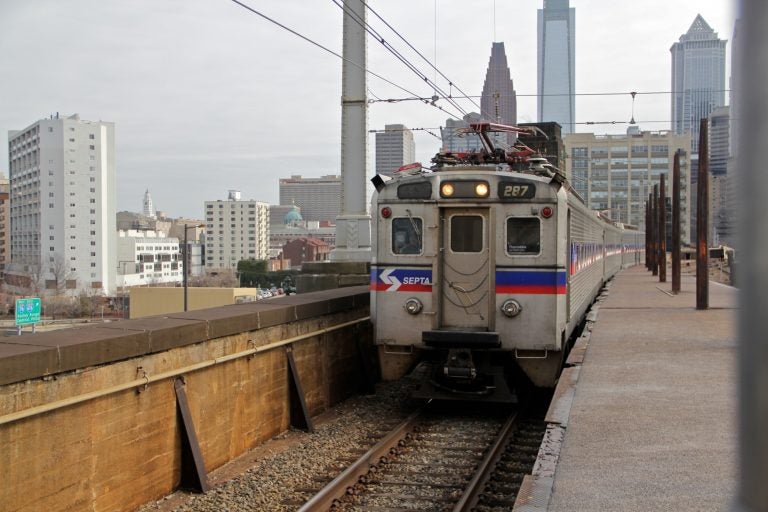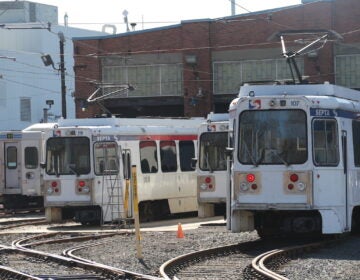Regional Rail is on life support. Essential workers can bring it back.
Ridership on Regional Rail is down 90%. SEPTA must change the system so it can serve essential workers — and draw people back to empty trains.

A train pulling into 30th Street Station. (Emma Lee/WHYY)
Institutions across the country are currently heeding the call to examine and dismantle cases of structural racism. As a transportation authority serving a city where people of color make up the majority, SEPTA must do the same with the Regional Rail system, a segment of the network that has long left behind this population.
In response to COVID-19, SEPTA has done an admirable job adjusting to public health guidance and shifts in ridership while also sustaining losses due to the pandemic. For a large agency, these necessary changes have come at lightning speed. We commend SEPTA’s performance under great adversity. We ask the agency to listen to the calls for social justice by adapting regional rail to serve working Philadelphians during the pandemic.
Picture a rail system that complements the rest of SEPTA’s network: Trains arriving every 15 minutes, fares that match the subway, and free transfers. Imagine how much this would aid our region’s people of color, many of whom are essential workers still commuting to their jobs.
Instead, the regional rail system we have today is a product of decades of structural racism. Built for shuttling suburban commuters to and from our city’s core during rush hours, it excludes Black and brown riders from low-income communities — many of whom work outside the traditional 9-to-5. As a result, the regional rail customer base is much whiter and wealthier than the average SEPTA rider.
As a result of SEPTA’s organizational structure, Regional Rail operates separately from the rest of the system rather than as part of an integrated network. While bus, subway, and trolley riders can transfer for free, regional rail riders cannot. This lack of integration hurts low-income riders who tend to travel farther to get to jobs dispersed throughout the region. Regional Rail stations serving low-income Philadelphia neighborhoods rank among those with the lowest ridership. One need only look at rail fares that are many times the cost of bus fares to see why. Many riders opt for the slower bus or trolley out of necessity even though rail is much faster.
A growing economic liability
COVID-19 has brought these issues to the forefront. The recent shift towards working from home has all but eliminated the suburban white-collar rail rider. As a result, ridership on Regional Rail is down an astonishing 90%. Essential workers, however, do not have this option and must still commute to their jobs. The ridership numbers highlight this disparity, with buses, subways, and trolleys collectively showing about 60 times more weekday ridership in July than all regional rail lines combined.
In response to abysmal Regional Rail ridership numbers, SEPTA has cut this service to the bone. The agency has suspended service entirely on two of its lines and has cancelled all late-night service.
We want SEPTA to do what it really takes to save Regional Rail: Incorporate it within an integrated network. We want SEPTA to restore service on all of its rail lines, lower regional rail fares to match bus, subway, and trolley fares within Philadelphia, and accept TransPass on regional rail trips within Philadelphia.
Operating regional rail is expensive, but it doesn’t have to be. SEPTA should look into examples of commuter rail modernization currently underway in Boston and already implemented in Berlin and Paris. Reimagining our regional rail network in this way would quickly increase system capacity and allow for better social distancing. It would bring riders onto empty trains and help thousands of low-income commuters throughout our region.
With the latest fare restructuring, SEPTA has shown a serious commitment to equity. By providing free transfers and free rides for children, the agency has demonstrated respect for people of color, youth, and low-income riders. SEPTA can continue this line of equitable thinking and better adapt to the new demographics of ridership. Reforming regional rail should be the next step SEPTA takes in order to cement the agency’s commitment to not just some but all of its customers.
Camille Boggan is a member of 5th Square’s Transit Committee and a city planning graduate student at the University of Pennsylvania.
Krista Guerrieri is an AICP-certified planner with a Master’s Degree in City Planning from the University of Pennsylvania, as well as a member of 5th Square’s Transit Committee.

Subscribe to PlanPhilly
WHYY is your source for fact-based, in-depth journalism and information. As a nonprofit organization, we rely on financial support from readers like you. Please give today.






![CoronavirusPandemic_1024x512[1]](https://whyy.org/wp-content/uploads/2020/03/CoronavirusPandemic_1024x5121-300x150.jpg)


